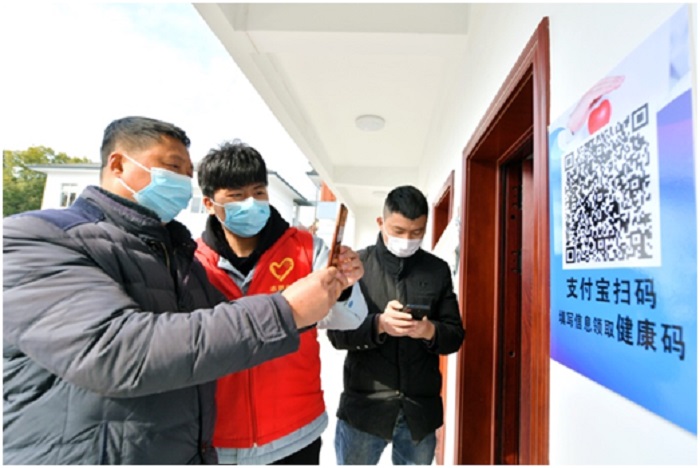



Mobile Internet-based health QR code has played an irreplaceable role in helping China prevent and control the COVID-19 epidemic, as well as the country’s efforts to resume work, production and businesses.
According to incomplete statistics, the health QR code has been launched in 31 provincial-level regions in the country since the outbreak.
Wang Yinghua, a 61-year-old citizen in Guiyang, southwest China’s Guizhou province, told the People’s Daily that residents had to fill their personal information when entering and exiting public places, including residential complexes, hospitals and parks, before the QR code was introduced. According to him, he had once waited for half an hour before he finally got into a community hospital with his grandson.
At present, the health code system has been vital in many scenarios, such as medical services, working, shopping and travel. It not only makes trips easier and faster, but also improves the efficiency of regular epidemic prevention and control. Besides, cities are also functioning in a more science-based and orderly manner because of it.
A total of over 400 staff members and volunteers in Beijing’s Jingshan neighborhood joined the information collecting and screening work for residents returning to the Chinese capital, who spent most of their time on door-to-door visits, making phone calls and manual registering, said Yan Yan, deputy head of the neighborhood’s community construction office.
Since the beginning of March, Beijing has introduced the health code system, which has not only reduced the workload of Yan and his colleagues, but also greatly improved their work efficiency.
Over 90 percent of 5,928 respondents have applied for a health code, said a recent survey conducted by People Think Tank, adding that the respondents generally had a positive feeling toward the service and gave a high recognition.
It is not easy developing from paper certificates to digital codes, said Li Xiaohui, a member of Shenzhen’s health code R&D team.
The R&D team needed to assist the local government in quickly determining and establishing standards on data collection and then design a technical framework that could support tens of millions of users simultaneously, said Li, who is also the technical director at the online government service operations of Chinese tech giant Tencent.
Despite the difficulties, the R&D team only used 7 days before rolling out the first version of health code for Shenzhen and the team has continuously updated the system according to actual needs of the city.
Nowadays, Internet companies such as Tencent and Alibaba are providing technical support for the application of health code in more and more cities.
In general, the health code systems launched in different regions in China have a lot in common.
For starters, they are all convenient and fast, fully taking account of factors such as the age and education level of residents. For instance, citizens in Hangzhou can apply for health codes for their family members who don’t own a smart phone, and the code will be related to the latter’s citizen cards.
The health code systems are also safe regarding private information. The People’s Government of Beijing Municipality specified that the data recorded in the city’s health code mini-program will only be preserved by the government and used for anti-epidemic purposes.
Besides, relevant data on the mini-program will expire at a certain point of each day, thus automatically protecting the information of users and standardizing data storage.
The results generated by the health code systems are accurate and authoritative, as these systems are connected to national databases, as well as those of the health, public security, railway, and civil aviation departments.
The health code system only collects basic and health information of residents, and the color-based system only shows part of the information in actual use, which significantly reduces the risk of personal privacy exposure, said Pan Helin, executive director of the Institute for Digital Economics at the Zhongnan University of Economics and Law.
The survey carried out by People Think Tank also suggests that over 90 percent of the respondents hope that health code will play a more important role in the post-pandemic era, especially in the fields of health, urban governance, transportation, as well as entertainment and tourism.
Health code system has brought many inspirations for social governance innovation and smart city construction, noted Pan, adding that it has combined various technologies like AI, big data, mobile communication, cloud computing, and blockchain, providing new direction for social governance.


The Executive and members of the.


The Acting Director, FCT Directorate of.


President Bola Ahmed Tinubu has been.



Barely a month after resignation of.


An Abuja based Legal Practitioner, Osuagwu.



Convener of Equitable Remedy, Mrs. Magaret.


Contractors handling the contract for city.


Nigerian government may have concluded plans.


The Diplomatic Correspondents Association of Nigeria.


A rights group, “Follow Me Talk.
Leave a Comment